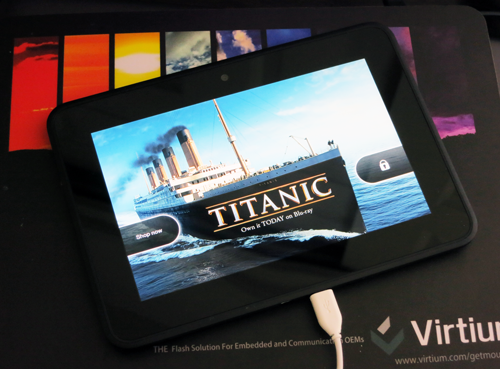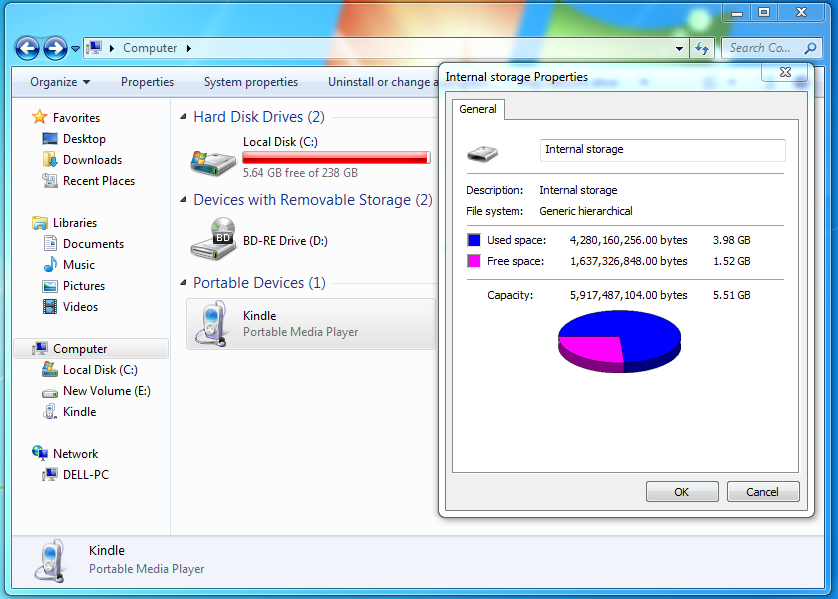Amazon's Kindle Fire HD: Better; Can It Compete With The Nexus 7?
Storage Performance: Amazon Fixes A Big Weakness
Although cables are inconvenient, plugging your tablet into your PC or Mac should be the quickest and easiest way to get content on it. Unfortunately, our experience with the first-gen Kindle was downright terrible. Transferring data was "excruciatingly slow," to quote our original review, requiring more than 17 minutes to copy a 2.8 GB movie. Those are nearly USB 1.1-class speeds.
Fortunately, this problem is fixed in the new tablets.
| USB File Transfer2.8 GB H.264-Encoded MP4 Movie | ||
|---|---|---|
| Row 0 - Cell 0 | Avg. Transfer Rate | Time |
| Amazon Kindle Fire, First-Gen (OS-Level File Transfer) | 2.76 MB/s | 17:14.615 |
| Amazon Kindle Fire, Second-Gen (OS-Level File Transfer) | 7.58 MB/s | 06:17.324 |
| Amazon Kindle Fire HD (OS-Level File Transfer) | 11.13 MB/s | 04:17.435 |
| Apple iPad 2 (iTunes) | 19.19 MB/s | 02:29.090 |
| Google Nexus 7 (OS-Level File Transfer) | 10.07 MB/s | 04:44.235 |
It appears that Amazon resolved its storage performance issues, seeing that the second-generation Kindle Fire requires just over six minutes to transfer our 2.8 GB file. That's roughly one-third of the time it took on the first-gen Fire. The Fire HD is actually the fastest Android-based tablet, averaging 11.13 MB/s. The iPad 2 outperforms them all, though, nearly halving the time taken by Amazon's Kindle Fire HD.
| Header Cell - Column 0 | Amazon Kindle Fire (First- and Second-Gen) | Amazon Kindle Fire HD | Apple iPad 2 |
|---|---|---|---|
| NAND Chip | Samsung KLM8G2FEJA | Samsung KLMAC2GE4A | Toshiba TH58NVG7D2FLA89 |
| NAND Bus | eMMC v4.41 | eMMC v4.45 | Toggle 1.0 |
| NAND Bus Speed | 104 Mb/s | 200 Mb/s | 133 Mb/s |
Why is there a discrepancy between the first- and second-generation Kindle Fires, and why does the iPad 2 perform so well?
Almost every Android-based tablet we have ever tested employs eMMC NAND, whereas Apple is the only major tablet manufacturer to use vanilla MLC NAND (the same stuff found in our favorite SSDs). Apple's SoCs contain extra logic to add block management and ECC. In contrast, MMC-based solutions handle management at the NAND level, so the operating system doesn't have to bother issuing commands. This also means that eMMC NAND is blind to most operating system functions, resulting in a significant amount of performance overhead.
Also, on its first-gen Kindle Fire, Amazon implemented a generic USB Mass Storage Class (MSC) driver. It is a detriment to performance, but a boon for system compatibility, since the tablet appears as a removable drive under Windows 7 and Mac OS X.
Like most other Android-based tablets, the second-generation Kindle Fire and Fire HD employ Microsoft's Media Transfer Protocol, which yields a significant storage performance bump. The tablets show up as plug-and-play media devices in Windows 7, but require Android File Transfer for compatibility in Mac OS X.
Get Tom's Hardware's best news and in-depth reviews, straight to your inbox.
Current page: Storage Performance: Amazon Fixes A Big Weakness
Prev Page CPU And GPU Performance Next Page LCD Performance Analysis



